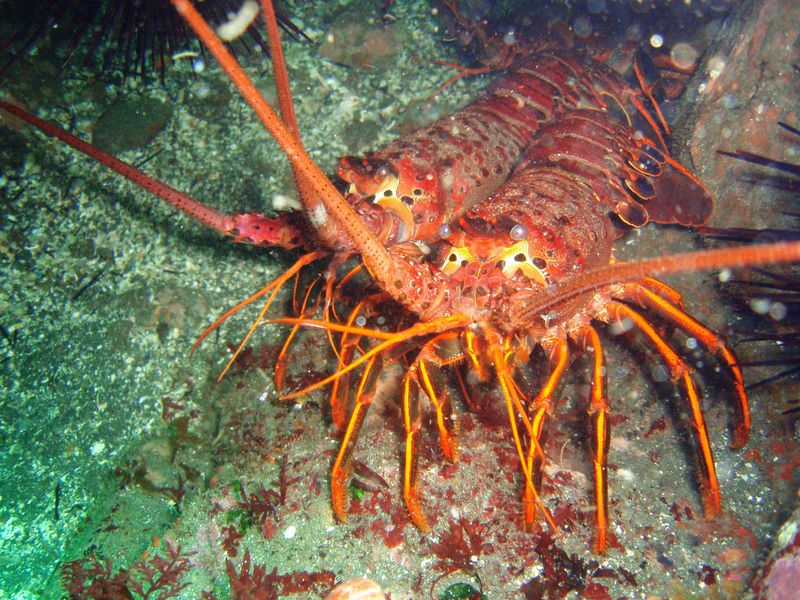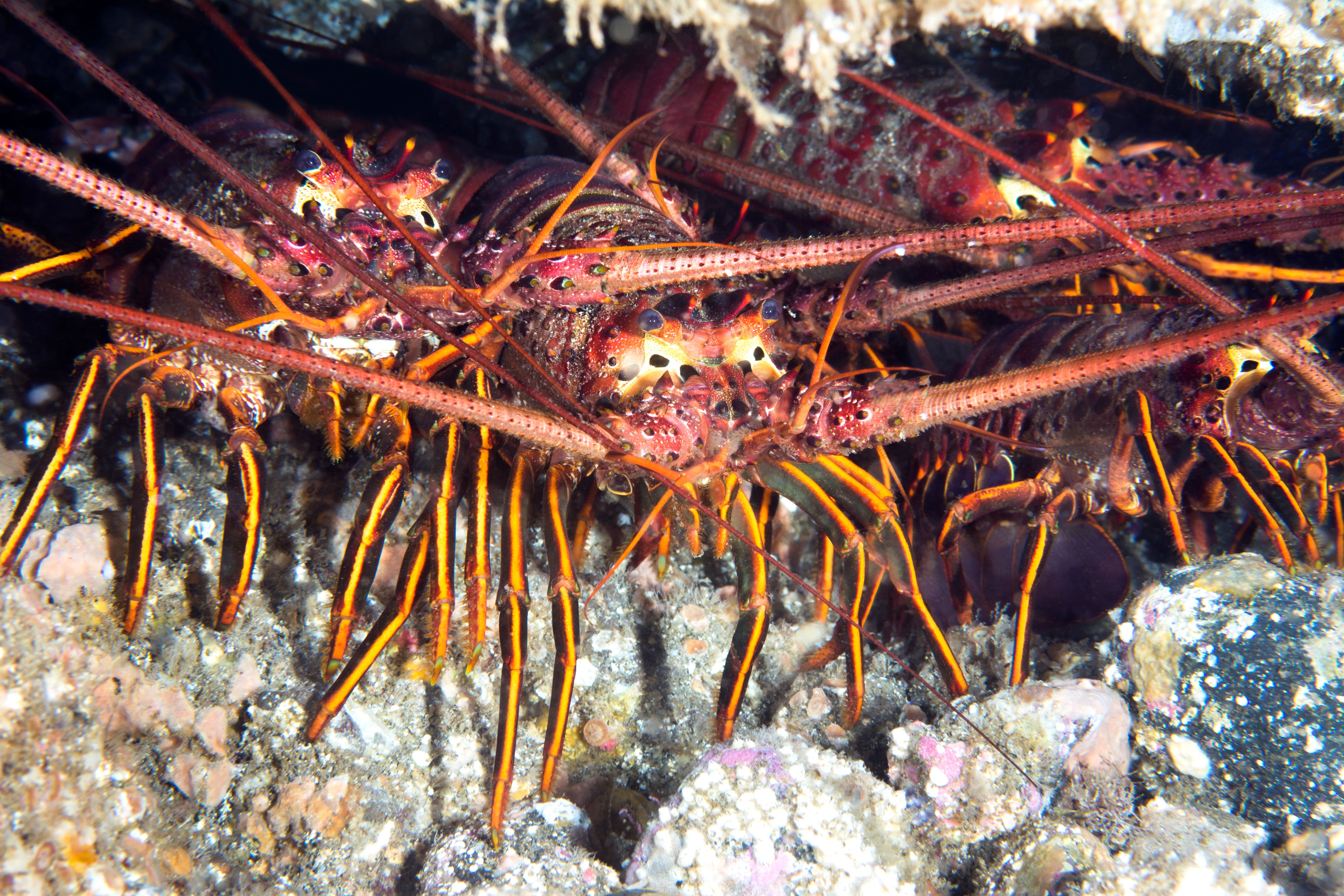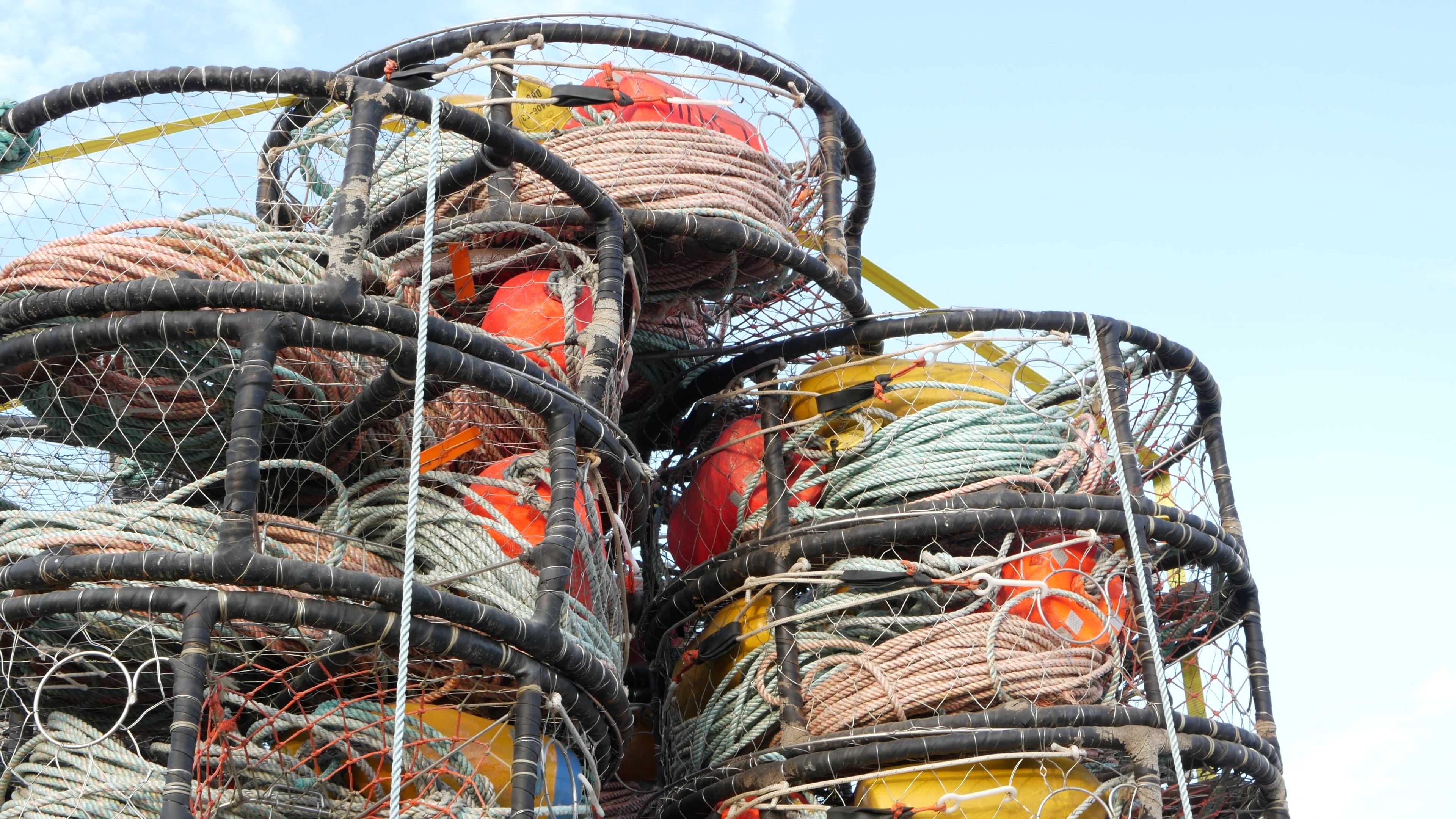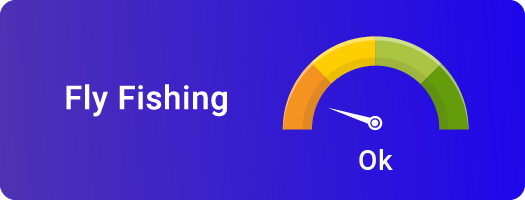California Lobster

Species Details
Panulirus interruptus
Palinuridae
Decapoda
Warm, rocky reef habitats and kelp forests
1 - 15 lbs.
24" - 1"
What makes the Spiny Lobster Different?
Unlike its clawed cousins, this lobster sports long, sweeping antennae and a tough, spiny shell that serves as its armor against predators. Instead of claws, it uses its powerful tail to dart backward at lightning speed when threatened.
The California lobster, also known as the California spiny lobster, is a fascinating marine creature. It thrives along the Pacific coast, from Monterey Bay to Baja California. Unlike its Maine counterpart, it lacks large claws but boasts long antennae and a spiny shell.
These lobsters inhabit rocky reefs, kelp forests, and seagrass beds. They prefer depths from the intertidal zone to 65 meters. Nocturnal by nature, they hide in crevices during the day and emerge at night to feed.
Their diet includes sea urchins, mollusks, and crustaceans. Spawning occurs from May to August, with females carrying eggs under their tails. Catching California lobsters is regulated, with a season running from October to March.
Fishermen need a license and a lobster report card. Size limits ensure sustainability, and common catching methods include hoop nets and diving. California lobsters are edible, known for their sweet, tender meat.
They are a delicacy in various dishes, from grilled lobster to lobster bisque. Conservation efforts protect their population, highlighting the importance of sustainable fishing practices.
What is the California Lobster?

The California lobster, scientifically known as Panulirus interruptus, is a unique species native to the Pacific coast. It's commonly called the California spiny lobster due to its distinctive features. Unlike the Maine lobster, the California spiny lobster lacks prominent claws. Instead, it is characterized by its long, spiny antennae and protective exoskeleton.
This lobster species plays a crucial role in the marine ecosystem. By controlling the population of sea urchins, it helps maintain balance within its habitat. The exoskeleton, covered in spines, serves as a defense mechanism against predators like sea otters and octopuses. This allows the lobster to navigate safely through its rocky environment.
California lobsters exhibit fascinating behaviors that differentiate them from other lobster species. For instance, they are known for their nocturnal nature. They emerge from their daytime shelters only when darkness falls. This night-time activity aids in avoiding daytime predators and optimizes their hunting efficiency.
Key characteristics of the California spiny lobster include:
- Long, spiny antennae for sensing environment
- No large claws, unlike other lobster species
- Exoskeleton offering protection from predators
These features help the California lobster thrive along the Pacific coast and play a vital role in its ecosystem.
Habitat: Where Do California Lobsters Live?
California lobsters inhabit the diverse and vibrant marine environments of the Pacific coast. They are typically found from Monterey Bay in California to Baja California in Mexico. This region offers the perfect conditions for their survival and growth.
These lobsters prefer rocky reefs and dense kelp forests. Such habitats provide the shelter and protection they need. The spiny lobster's exoskeleton helps them blend into these rocky landscapes, offering camouflage from predators.
Seagrass beds are another favored environment for the California spiny lobster. The beds offer abundant food sources. These areas provide the ideal conditions for hiding during the day. This choice of habitat protects them from predators while resting.
California lobsters thrive at varying depths, from the intertidal zone to about 65 meters. This broad range of habitats showcases their adaptability. Despite their preference for specific environments, they can handle a variety of oceanic conditions.
Key elements of their habitat include:
- Rocky reefs for shelter and camouflage
- Kelp forests rich in food and safety
- Seagrass beds providing nourishment and protection
By inhabiting these areas, California lobsters maintain their critical role in the marine ecosystem. Their adaptation to these diverse habitats ensures their survival and underlines their ecological importance. This understanding of their living conditions gives valuable insights into marine biodiversity and balance.

Behavior and Life Cycle
The California spiny lobster exhibits unique behavior patterns that adapt well to its environment. These creatures are primarily nocturnal. They remain hidden in rocky crevices during the day. At night, they venture out in search of food.
When it comes to the life cycle, these lobsters have intriguing stages. After hatching, larvae drift in ocean currents for months. This pelagic phase allows them to disperse widely. As they mature, they settle in suitable habitats near the coast.
Once they reach a certain size, lobsters undergo molting. Molting involves shedding their exoskeleton to allow for growth. During this vulnerable period, they hide to avoid predators. Growing a new shell is energy-intensive, so they remain sheltered until it hardens.
Several elements are crucial to understanding their life cycle:
- Hatching and Larval Stage: Floating in ocean currents
- Settlement: Moving to coastal habitats as they mature
- Molting: Shedding their exoskeleton for growth
Recognizing these life stages helps us appreciate how environmental factors affect their growth and survival. Their nocturnal habits and unique life cycle illustrate the adaptive nature of California lobsters. Understanding these behaviors aids in both conservation efforts and sustainable fishing practices.
What Do California Lobsters Eat?
California lobsters have a diverse diet, helping them thrive in various marine environments. They primarily feed on sea urchins, mollusks, and small crustaceans. This varied diet supports their nutritional needs effectively.
These lobsters are opportunistic feeders, consuming available food sources. Detritus, or organic debris, also forms a part of their diet. By feeding on different prey, they help maintain ecological balance in their habitats.
In addition to being scavengers, California lobsters play a key role in controlling prey populations. Their diet may include:
- Sea Urchins: Helping to control their abundance
- Mollusks: Snails and clams
- Crustaceans: Such as crabs and shrimp
- Detritus: Organic debris from the ocean floor
This role is crucial in sustaining the health of marine ecosystems. Their ability to feed on a wide range of prey ensures that they adapt well to their environments, contributing to the rich biodiversity of their coastal habitats.
Spawning and Molting: The Lobster’s Life Stages
The life stages of California lobsters are fascinating and crucial for their survival. Spawning occurs from May to August. During this period, females carry eggs under their tails.
The eggs stay attached until they hatch. This ensures a higher chance of survival in the ocean’s vastness. Females can lay thousands of eggs, enhancing the species' continuity.
Molting is another pivotal stage for lobsters. To grow, they must shed their exoskeleton. This process leaves them vulnerable to predators temporarily.
After molting, lobsters hide until their new shell hardens. This crucial period impacts their growth and survival. Key life stages for California lobsters include:
- Spawning: From May to August
- Egg Carrying: Until hatching
- Molting: Shedding the exoskeleton
- Post-Molt: Seeking shelter for protection
Understanding these stages helps us appreciate their resilience. Protecting their habitats ensures sustainable populations. Sustainable practices support the delicate balance of marine ecosystems, benefiting the broader environment.
Laws and Regulations for Catching California Lobster

Fishing for California lobsters involves specific legal regulations. These rules ensure sustainable harvesting and protect the species. Understanding these guidelines is crucial for enthusiasts and professionals alike.
In California, a valid fishing license is mandatory. Alongside this, a lobster report card is essential. Both documents ensure that records of the catch are maintained accurately.
The lobster season in California typically runs from early October to mid-March. This period allows the population to regenerate during their spawning season. Fishers must strictly adhere to these seasonal timelines.
Size limits are in place for legal catches. Lobsters must meet a minimum carapace length. This rule ensures juveniles have time to mature and reproduce before being harvested.
The use of specific tools is also regulated. Hoop nets and diving are commonly permitted methods. Other equipment may be restricted to minimize bycatch and protect juveniles.
There are marine protected areas where catching lobsters is prohibited. These zones help conserve marine life diversity and maintain ecological balance. Fishers should verify these locations before setting out.
For both recreational and commercial fishers, understanding these laws is critical. Compliance ensures the long-term sustainability of the lobster population. Sustainable practices benefit the broader marine ecosystem.
Key Regulations Include:
- Fishing License: Required for all fishers.
- Lobster Report Card: Mandatory for tracking purposes.
- Season: October to March.
Tools and Locations:
- Permitted Tools: Hoop nets and diving.
- Protected Areas: Verify no-fishing zones.
Lobster Season in California: When and Where to Catch Them
California’s lobster season is eagerly anticipated by many. Starting in early October, it extends to mid-March. This five-month window is your opportunity to catch these prized creatures.
During this period, lobsters are more active and abundant. The timing aligns with cooler ocean temperatures. This change makes them more accessible to divers and fishers alike.
Prime locations for catching California lobsters vary along the coast. Popular spots include areas from Monterey Bay down to Baja California. Rocky reefs and kelp forests are favored habitats to explore.
As you plan your expedition, remember to check local regulations. Some regions might impose additional restrictions. Protecting the environment and ensuring fair fishing is crucial.
Tips for Successful Lobstering:
- Timing: Go early in the season.
- Location: Target rocky reefs and kelp areas.
- Preparation: Verify local restrictions before heading out.
Exploring these aspects can enhance your lobstering experience. With careful planning, you can responsibly enjoy this unique activity. Respecting the guidelines benefits both the ecosystem and future fishing seasons.
Methods for Catching California Lobster
Catching California lobster requires skill and the right tools. Hoop nets and diving are the two most popular methods. Each offers a unique experience with its own challenges and rewards.
Hoop nets are user-friendly, especially for beginners. They are usually set in the evening and left overnight. This method allows lobsters to be lured into the net by bait, making it a simpler option.
Diving for lobsters, however, is more adventurous. It involves exploring underwater reefs and crevices. This method requires a keen eye and quick reflexes to catch lobsters by hand.
Key Methods for Lobster Catching:
- Hoop Nets: Good for beginners, set overnight.
- Diving: More challenging, requires skill and attention.
- Bait: Essential for hoop nets, often fish or chicken.
Both methods have their merits and appeal to different types of people. Respecting guidelines ensures sustainability and safety for all involved.
Conservation and Sustainability Efforts
Conservation efforts for California lobsters are essential to maintaining their populations. Overfishing and habitat loss present significant threats. Authorities work tirelessly to implement strategies that safeguard these marine creatures.
The California Department of Fish and Wildlife (CDFW) leads these initiatives. They enforce size limits and seasonal restrictions to protect breeding stocks. These regulations aim to balance fishing practices with lobster population health.
Marine protected areas (MPAs) offer vital habitats for lobsters. These zones ensure safety from human activities. MPAs help maintain biodiversity and allow ecosystems to thrive.
Key Conservation Strategies:
- Size Limits: Protects juveniles and ensures maturity.
- Seasonal Restrictions: Guards against overfishing.
- Marine Protected Areas: Preserve natural habitats.
Through these combined efforts, sustainability becomes achievable. Protecting lobsters ensures future generations can enjoy these unique creatures. It highlights the importance of responsible fishing practices in our oceans.
Are California Lobsters Edible? Taste, Culinary Uses, and Nutrition
California lobsters are indeed edible and considered a delicacy. Their sweet, tender meat makes them highly sought after. This spiny crustacean offers a unique taste compared to its clawed counterparts.
In culinary circles, California lobsters shine in diverse dishes. Chefs prepare them grilled, broiled, or even in tacos. Their versatility allows for creative culinary expressions. When cooked correctly, the flavors are rich and savory.
Popular Culinary Uses:
- Grilled Lobster: Enhances natural sweetness.
- Lobster Tacos: A fusion delight.
- Lobster Bisque: Luxuriously creamy.
Nutritionally, lobsters are a rich source of protein. They are low in fat and provide essential minerals like zinc and phosphorus. This makes them a healthy choice for seafood lovers.
Key Nutritional Benefits:
- High in Protein: Supports muscle development.
- Low in Fat: Ideal for balanced diets.
- Essential Minerals: Boosts overall health.
Enjoying California lobsters is more than just a culinary experience. It involves appreciating a sustainable seafood choice. By choosing responsibly sourced lobsters, you contribute to ocean conservation.
Key Takeaways: Learn About California Lobster
Understanding the California lobster opens a window to the marine world. This intriguing species enriches not only the ocean ecosystem but also our dining tables. Their striking appearance and fascinating behavior captivate both scientists and seafood lovers.
Highlights of the California Lobster:
- Inhabits rocky reefs and kelp forests.
- Feeds mainly on sea urchins and mollusks.
- Offers a sweet, tender culinary experience.
Engaging with these lobsters can teach us about sustainable fishing practices. They play a pivotal role in the balance of marine life. Appreciating them fosters a connection to the waters off our coasts.







